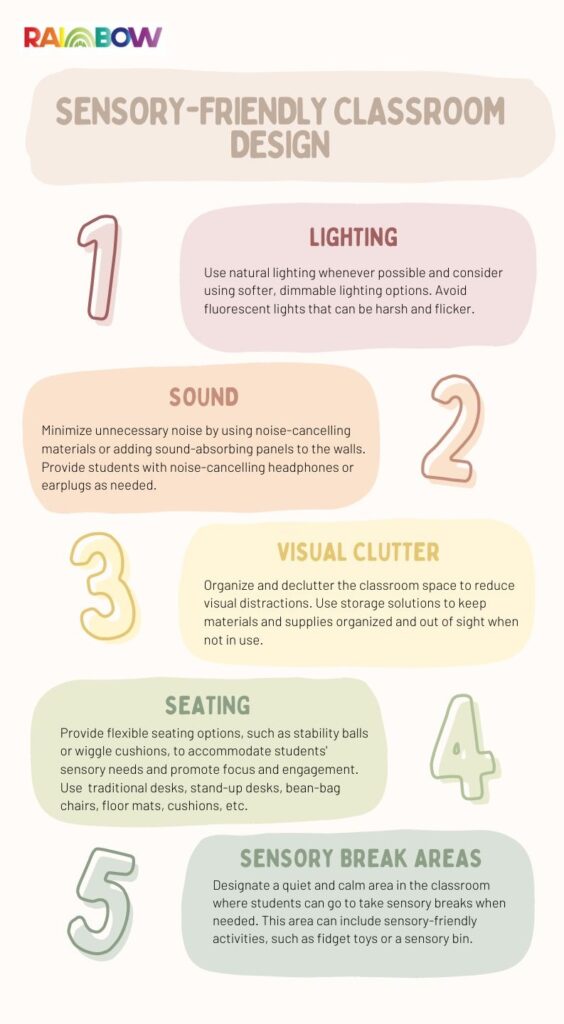To create an inclusive classroom environment for students with autism, it’s essential to have a clear understanding of their characteristics and the impact it has on their learning and social interaction.

Characteristics of Autism in Students
Autism, also known as Autism Spectrum Disorder (ASD), is a neurodevelopmental disorder that affects individuals in various ways. While each person with autism is unique, there are some common characteristics that can be observed in students with autism.
Difficulty with social interaction: Students with autism typically struggle with social cues, making it challenging to initiate and maintain conversations or grasp non-verbal communication like facial expressions and body language. They may prefer to engage in solitary activities or have difficulty forming friendships.
Sensory sensitivities: Many individuals with autism have heightened sensitivity to sensory stimuli, such as bright lights, loud noises, or certain textures. These sensitivities can impact their ability to focus and remain calm in a traditional classroom environment.
Rigid thinking and adherence to routines: Students with autism often benefit from structure, routine, and clear expectations. They may find it difficult to cope with ambiguity or situations where they interact with new people or deal with unexpected changes.
Special interests: Autistic individuals often have intense interests in specific topics or subjects. They may display an exceptional level of knowledge and focus on these interests and can benefit from incorporating these interests into their learning.

Impact on Learning and Social Interaction
Autism can have a significant impact on a student’s learning and social interaction within the classroom setting. Understanding these challenges is crucial for creating an inclusive learning environment.
- Reading and verbal comprehension challenges: Children on the autism spectrum typically have difficulty with reading and verbal comprehension, particularly when it comes to figurative or expressive language. They may struggle with understanding idioms, metaphors, or jokes.
- Executive functioning difficulties: Students with autism excel when given clear direction and guidance and can focus deeply on a particular subject. However, they may struggle with executive functioning skills such as following through on multi-step projects, organizing their thoughts, and switching between topics and activities.
- Sensory processing difficulties: Autistic individuals may experience difficulties with sensory processing, where they may be hypersensitive or hyposensitive to certain sensory stimuli. This can impact their ability to concentrate, maintain attention, and regulate their emotions in a classroom setting.
- Unique learning preferences: Students with autism often benefit from visual supports, such as visual schedules, charts, or diagrams, to aid in understanding and retaining information. They may require additional time to process information and benefit from clear, concise instructions.
By understanding the characteristics of autism in students and recognizing the impact it has on their learning and social interaction, educators and caregivers can implement strategies and create an inclusive classroom environment that supports their individual needs.

Creating an Inclusive Classroom Environment
In order to foster an inclusive classroom environment for students with autism, it is essential to create an atmosphere that is supportive, structured, and accommodating. Two key components of such an environment are structured routines and clear expectations, as well as a sensory-friendly classroom design.
Structured Routines and Clear Expectations
Students with autism may struggle with ambiguity or situations where they interact with new people or deal with unexpected changes. Establishing consistent daily routines and clearly communicating expectations can help create a sense of predictability and comfort for these students.
To implement structured routines and clear expectations, educators can:
- Develop a visual schedule that outlines the daily activities and transitions in a clear and sequential manner. This can be in the form of a visual timetable displayed in the classroom.
- Use visual aids, such as visual timers, to help students understand the duration of activities and transitions.
- Break down tasks into smaller, manageable steps, providing clear instructions and expectations for each step.
- Incorporate visual supports, such as visual prompts or cue cards, to reinforce desired behaviors and facilitate understanding of classroom rules and procedures.
- Provide consistent feedback and reinforcement to reinforce positive behaviors and help students understand the expectations of the classroom.
By establishing structured routines and clear expectations, educators can create a supportive and predictable environment that allows students with autism to feel more secure and engaged in the learning process.
Sensory-Friendly Classroom Design
Students with autism may experience sensory overload in a classroom environment due to factors such as hall buzzers, fluorescent lights, loud noises, and disordered environments. Creating a sensory-friendly classroom design can help minimize sensory distractions and promote a more comfortable learning environment for students with autism.
Consider the following strategies for sensory-friendly classroom design:

By considering the sensory needs of students with autism and making appropriate adjustments to the classroom environment, educators can create an inclusive setting that supports their learning and reduces sensory challenges.
Creating an inclusive classroom environment involves thoughtful planning and consideration of the unique needs of students with autism. By implementing structured routines, clear expectations, and a sensory-friendly classroom design, educators can cultivate an environment that promotes engagement, comfort, and success for all students.

Tailoring Instruction for Students with Autism
In order to create an inclusive classroom environment for students with autism, it is important to tailor instruction to address their unique challenges and support their learning and development. This section focuses on two key areas: addressing reading and verbal comprehension challenges and supporting executive functioning skills.
Addressing Reading and Verbal Comprehension Challenges
Students with autism often face difficulties when it comes to reading and verbal comprehension, especially when encountering figurative or expressive language.
One effective approach is to use visual supports, such as visual schedules, graphic organizers, and visual cues, to provide additional context and support comprehension. Breaking down complex information into smaller, more manageable parts can also help students with autism process and understand the content more effectively. Teachers can provide visual representations, simplify language, and provide step-by-step instructions to facilitate comprehension.
Additionally, incorporating multisensory activities and materials can engage different modalities and reinforce understanding. For example, using manipulatives, videos, or interactive technology can provide a more interactive and engaging learning experience for students with autism.

Supporting Executive Functioning Skills
Executive functioning skills, which include planning, problem-solving, organization, and time management, can be challenging for students with autism. These skills are crucial for academic success and independent functioning, both in and out of the classroom.
Teachers can provide support by breaking tasks down into smaller, manageable steps and providing clear and explicit instructions. Visual aids, such as checklists and visual schedules, can help students with autism stay organized and focused on their tasks. It is important to allow extra time for transitions and provide reminders to help students with autism manage their time effectively.
Building routines and consistency in the classroom can also support executive functioning skills. Providing clear expectations and establishing predictable structures can help students with autism better navigate their daily activities and tasks.
By addressing reading and verbal comprehension challenges and supporting executive functioning skills, teachers can create a more inclusive and supportive learning environment for students with autism. It is important to individualize instruction and provide targeted support based on each student’s unique needs, strengths, and challenges.

Enhancing Fine and Gross Motor Skills
Students with autism may face challenges in developing fine and gross motor skills, which are crucial for their learning and interaction within the classroom. In this section, we will explore strategies for motor skill development and reducing stimming behaviors in an inclusive classroom environment.
Strategies for Motor Skill Development
Implementing specific strategies can help students with autism enhance their fine and gross motor skills. These strategies may include:
- Physical Activities and Exercise: Encouraging physical activities and exercise can promote the development of both fine and gross motor skills. Activities such as yoga, dance, and sports can help students improve coordination, balance, and strength.
- Fine Motor Skill Activities: Engaging students in activities that target fine motor skills, such as using scissors, playing with building blocks, or manipulating small objects, can help them develop hand-eye coordination and dexterity.
- Visual Supports: Providing visual supports, such as visual schedules or step-by-step instructions, can assist students in understanding and organizing their movements. Visual cues can enhance their motor planning abilities and promote independence.
- Handwriting Practice: Regular practice of handwriting exercises can aid in the development of fine motor skills. Using activities that strengthen hand muscles, such as squeezing stress balls or using playdough, can also be beneficial.
Reducing Stimming Behaviors
Stimming behaviors, also known as self-stimulatory behaviors, are repetitive movements or actions that individuals with autism engage in. These behaviors can sometimes interfere with learning and social interactions. While it’s important to respect and understand the individual’s needs and preferences, reducing stimming behaviors can provide a more focused and inclusive classroom environment. Here are some strategies to consider:
- Sensory Breaks: Providing scheduled sensory breaks can offer students an opportunity to engage in stimming behaviors in a controlled manner. These breaks can help regulate sensory input and reduce the need for spontaneous stimming during instructional time.
- Alternative Sensory Tools: Introducing alternative sensory tools, such as fidget toys, stress balls, or chewable jewelry, can redirect stimming behaviors to more socially acceptable outlets. These tools can provide sensory input and help students maintain focus.
- Social Stories and Visual Prompts: Using social stories and visual prompts can help students understand appropriate times and places for stimming behaviors. By providing clear explanations and expectations, students can learn alternative strategies for self-regulation.
- Positive Reinforcement: Implementing a positive reinforcement system can encourage students to decrease stimming behaviors. Recognizing and rewarding desired behaviors can motivate students to engage in more socially appropriate activities.
By implementing these strategies, educators and caregivers can support students with autism in developing their motor skills while also creating a more inclusive and focused learning environment. It’s important to individualize these approaches based on each student’s unique needs and preferences.

Strategies for Success in Post-Secondary Education
As autistic students transition into post-secondary education, it is crucial to provide them with the support and accommodations they need to thrive in this new academic environment. Tailoring teaching approaches and creating inclusive classrooms can greatly contribute to their success. Let’s explore two key strategies for supporting autistic students in tertiary education: supporting autistic students in tertiary education and individualized teaching approaches.
Supporting Autistic Students in Tertiary Education
Autistic students have been traditionally associated with enrolling in STEM-based degree areas. However, it is essential to recognize that they can excel in a wide range of subjects and degrees. Inclusive classrooms, which have become the norm due to the Individuals with Disabilities Education Act (IDEA), mandate that children with disabilities, including those with Autism Spectrum Disorder (ASD), receive education alongside their peers.
Over 60% of students with autism and disabilities spend 80% or more of their time at school in regular classrooms. This inclusive model is believed to benefit both students with disabilities and those without by providing more instructional time, reducing school absences, and improving post-secondary outcomes for students with disabilities. Additionally, it enhances opportunities for neurotypical students to form relationships with peers regardless of disability status.
To support autistic students in tertiary education, it is vital to create an inclusive and accepting environment. This can be achieved by promoting awareness and understanding of autism among faculty, staff, and students. Encouraging open communication and providing resources such as support groups or counseling services can also contribute to a more supportive learning environment.

Individualized Teaching Approaches
Inclusive classrooms require teachers to be aware of the academic, social, and emotional needs of students on the autism spectrum. It is important to recognize that students with autism process information differently, and therefore, teachers must tailor their instruction and procedures to ensure all students benefit.
Implementing individualized teaching approaches can greatly enhance the learning experience for autistic students. This involves understanding each student’s unique strengths, weaknesses, and learning styles. By adapting teaching methods, materials, and assessments to meet individual needs, teachers can create a more inclusive and effective learning environment.
Some strategies that can be employed include providing visual aids and visual schedules to support organization and understanding, breaking down complex tasks into smaller, manageable steps, and offering additional time or alternative formats for assignments and exams. Regular communication with students and their support networks is also essential to ensure ongoing support and adjustment of teaching strategies as needed.
By supporting autistic students in tertiary education and employing individualized teaching approaches, post-secondary institutions can create an environment that fosters academic success, personal growth, and inclusivity. When students feel supported and understood, they are more likely to thrive in their educational pursuits and make valuable contributions to their chosen fields.
Sources:
- https://www.autismparentingmagazine.com/ways-to-build-inclusive-classroom/
- https://www.adcet.edu.au/inclusive-teaching/specific-disabilities/autism
- https://tesidea.com/blog/autism-inclusion-in-the-classroom/
- https://degree.lamar.edu/online-programs/education/med/special-education/autism-affects-inclusive-classroom/

